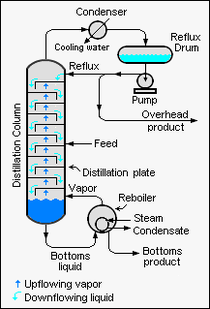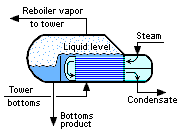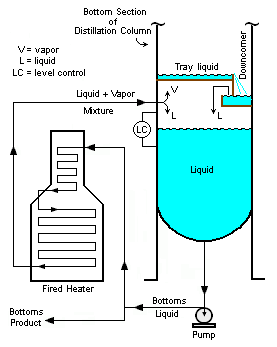User:Milton Beychok/Sandbox: Difference between revisions
imported>Milton Beychok |
imported>Milton Beychok No edit summary |
||
| Line 11: | Line 11: | ||
Commonly used heat exchanger type reboilers are: | Commonly used heat exchanger type reboilers are: | ||
[[Image:Kettle reboiler. | [[Image:Kettle reboiler.png|right|thumb|184px|{{#ifexist:Template:Kettle reboiler.png/credit|{{Kettle reboiler.png/credit}}<br/>|}}Figure 2: A typical steam-heated kettle reboiler used for heating industrial distillation columns.]] | ||
===Kettle reboilers=== | ===Kettle reboilers=== | ||
Figure 2 depicts a typical steam-heated kettle reboiler used for heating industrial distillation columns. Kettle reboilers are very simple and reliable. They may require [[pump|pumping]] of the column bottoms liquid into the kettle, or there may be sufficient [[Head (fluid dynamics)|liquid head]] to deliver the liquid into the reboiler. In this reboiler type, steam flows through the tube bundle and exits as condensate. The liquid from the bottom of the tower, commonly called the '''bottoms''', flows through the shell side. There is a retaining wall or overflow '''weir''' separating the tube bundle from the reboiler section where the residual reboiled liquid (called the bottoms product) is withdrawn, so that the tube bundle is kept covered with liquid. | Figure 2 depicts a typical steam-heated kettle reboiler used for heating industrial distillation columns. Kettle reboilers are very simple and reliable. They may require [[pump|pumping]] of the column bottoms liquid into the kettle, or there may be sufficient [[Head (fluid dynamics)|liquid head]] to deliver the liquid into the reboiler. In this reboiler type, steam flows through the tube bundle and exits as condensate. The liquid from the bottom of the tower, commonly called the '''bottoms''', flows through the shell side. There is a retaining wall or overflow '''weir''' separating the tube bundle from the reboiler section where the residual reboiled liquid (called the bottoms product) is withdrawn, so that the tube bundle is kept covered with liquid. | ||
===Thermosyphon reboilers === | ===Thermosyphon reboilers === | ||
Revision as of 21:54, 25 July 2008
Reboilers are heat exchangers typically used to provide heat to the bottom of industrial distillation columns. They boil the liquid from the bottom of a distillation column to generate vapors which are returned to the column to drive the distillation separation.
Proper reboiler operation is vital to effective distillation. In a typical classical distillation column, all the vapor driving the separation comes from the reboiler. The reboiler receives a liquid stream from the column bottom and may partially or completely vaporize that stream. Steam usually provides the heat required for the vaporization.
Types of reboilers
The most critical element of reboiler design is the selection of the proper type of reboiler for a specific service. Most reboilers are of the shell and tube heat exchanger type and normally steam is used as the heat source in such reboilers. However, other heat transfer fluids like hot oil or Dowtherm (TM) may be used. Fuel-fired furnaces may also be used as reboilers in some cases.
Commonly used heat exchanger type reboilers are:
Kettle reboilers
Figure 2 depicts a typical steam-heated kettle reboiler used for heating industrial distillation columns. Kettle reboilers are very simple and reliable. They may require pumping of the column bottoms liquid into the kettle, or there may be sufficient liquid head to deliver the liquid into the reboiler. In this reboiler type, steam flows through the tube bundle and exits as condensate. The liquid from the bottom of the tower, commonly called the bottoms, flows through the shell side. There is a retaining wall or overflow weir separating the tube bundle from the reboiler section where the residual reboiled liquid (called the bottoms product) is withdrawn, so that the tube bundle is kept covered with liquid.
Thermosyphon reboilers
These do not require pumping of the column bottoms liquid into the reboiler. Natural circulation is obtained by using the density difference between the reboiler inlet column bottoms liquid and the reboiler outlet liquid-vapor mixture to provide sufficient liquid head to deliver the tower bottoms into the reboiler. Thermosyphon reboilers are more complex than kettle reboilers and require more attention from the plant operators.
There are many types of thermosyphon reboilers. They may be vertical or horizontal and they may also be once-through or recirculating. Some fluids being reboiled may be temperature-sensitive and, for example, subject to polymerization by contact with high temperature heat transfer tube walls. In such cases, it is best to have a high liquid recirculation rate to avoid having high tube wall temperatures which would cause polymerization and, hence, fouling of the tubes. The thermosiphon reboiler depicted in Image 2 is a typical steam-heated recirculating thermosiphon reboiler.
Relative volatility of feed to reboiler must be considered before designing thermosyphon reboilers.
Fired reboiler
Fired heaters (furnaces) may be used as a distillation column reboiler. A pump is required to circulate the column bottoms through the heat transfer tubes in the furnace's convection and radiant sections.
Image 3 depicts a fired heater being used in a configuration that provides recirculation of the column bottoms liquid. However, with some relatively minor changes inside the bottom section of the distillation column, a fired heater can also be used in once-through configuration.
The heat source for the fired heater reboiler may be either fuel gas or fuel oil. Coal would rarely, if ever, be used as the fuel for a fired heater reboiler.
Forced circulation reboilers
This type of reboiler uses a pump to circulate the column bottoms liquid through the reboilers. Image 4 depicts a typical steam-heated forced circulation reboiler.
It should be noted steam is not the only heat source that can be used. Any fluid stream at a high enough temperature could be used for any of the many shell and tube heat exchanger reboiler types.
See also
Further reading
- Kister, Henry Z. (1992). Distillation Design, 1st Edition. McGraw-Hill. ISBN 0-07-034909-6.
- Perry, Robert H. and Green, Don W. (1984). Perry's Chemical Engineers' Handbook, 6th Edition. McGraw-Hill. ISBN 0-07-049479-7.



